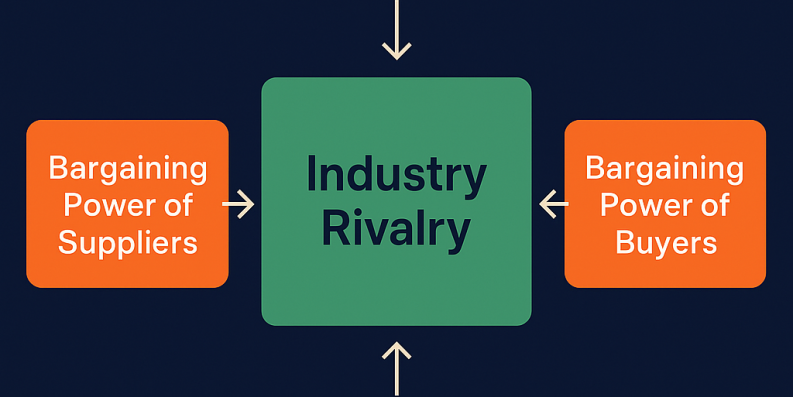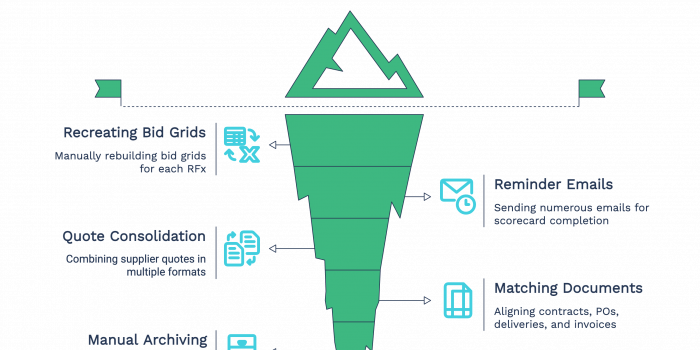Decoding Supplier Power: How Scale Applies Porter’s Five Forces in Procurement
In today’s procurement environment, knowing your supplier is no longer enough, you need to understand their market. Who controls pricing? Are there substitutes? Can new entrants disrupt your supply chain? These are strategic questions that Porter’s Five Forces helps answer — and at Scale, we’ve embedded this thinking to help

In today’s procurement environment, knowing your supplier is no longer enough, you need to understand their market. Who controls pricing? Are there substitutes? Can new entrants disrupt your supply chain? These are strategic questions that Porter’s Five Forces helps answer — and at Scale, we’ve embedded this thinking to help procurement teams build smarter, more resilient sourcing strategies.
What Are Porter’s Five Forces?
Developed by Michael E. Porter, the Five Forces framework is a business analysis tool used to assess the competitiveness of a market. It helps organizations understand the dynamics influencing profitability, pricing, and risk.
Here’s how each force applies to procurement:
- Supplier Power: How much leverage suppliers have over pricing, terms, and delivery
- Buyer Power: How much influence your organization has over the supplier
- Threat of Substitutes: Are there alternative products/services that can replace this supply?
- Threat of New Entrants: Can new suppliers easily enter the market and disrupt incumbents?
- Industry Rivalry: How competitive is the supplier landscape in this category?\
Procurement is no longer a back-office function. It’s a strategic lever that can unlock value, reduce risk, and give companies a competitive edge. But to make smart sourcing decisions, buyers must understand the dynamics of the supplier’s market — and that’s where Porter’s Five Forces comes in.
Why Porter’s Five Forces Matter in Procurement
1. It Helps You See the Full Market Picture — Not Just the Supplier
Porter’s Five Forces forces you to ask:
- How competitive is their industry?
- Do they control pricing or depend on one buyer? This 360-degree view enables you to anticipate risks and negotiate from a position of strength.
2. It Improves Supplier Negotiation Strategy
If you know where your suppliers stand in the market, you can:
- Push harder on pricing in competitive markets
- Strengthen long-term ties where supplier power is high
- Ask for more value in markets with many substitutes
3. It Helps You Prioritize Procurement Efforts
You can now:
- Focus on monopolistic or high-dependency suppliers
- Automate where rivalry is high and price control is low
- Allocate time and budget to categories with greater risk or complexity
4. It Supports Risk Management and Continuity Planning
You’ll better identify:
- Supply disruptions from limited options
- Innovation threats from substitute products
- Exposure to volatile suppliers or unstable markets
5. It Aligns Procurement with Business Strategy
CEOs use the Five Forces. Now procurement can, too. This enables:
- Strategic sourcing alignment
- Better communication at board level
- More informed decisions on outsourcing, partnerships, and supplier investments
6. Especially Valuable in African Procurement
In fragmented or underdeveloped markets, Five Forces:
- Bring structure to ambiguous supplier environments
- Help procurement teams make strategic decisions with limited data
- Empower local organizations to compete like multinationals
How Scale Embeds Porter’s Five Forces
At Scale, we go beyond transactional sourcing — we help organizations think strategically. Here’s how we bring each force to life in real-world procurement:
1. Supplier Power — Scored and Visualized
-
How Scale Helps: During supplier onboarding and evaluation, we collect data on supplier concentration, unique capabilities, switching costs, and delivery control.
-
Result: Procurement teams can identify where supplier dominance is high and design negotiation or risk mitigation strategies accordingly.
Example: If only 3 suppliers exist for a critical service, Scale flags high supplier power and recommends long-term contracts or dual sourcing.
2. Buyer Power — Increased Through Centralization
-
How Scale Helps: By digitizing all tenders, requisitions, and supplier engagements in one place, Scale gives procurement teams negotiation leverage through consolidated demand visibility.
-
Result: Stronger buyer position across more categories, especially in commoditized purchases.
Example: A buyer using Scale for 12 departments can pool orders across locations and use their collective volume to negotiate better terms.
3. Threat of Substitutes — Highlighted During Supplier Evaluation
-
How Scale Helps: Our supplier comparison tools allow buyers to explore alternative options, categories, or technologies during RFPs and prequalification.
-
Result: Teams can assess the feasibility and cost of switching to substitutes when needed.
Example: A buyer sourcing packaging can compare paper, jute, and plastic options with environmental and cost data side by side.
4. Threat of New Entrants — Managed via Prequalification and Verification
-
How Scale Helps: Scale’s prequalification and business verification modules assess the ease with which new suppliers can enter and compete.
-
Result: Procurement teams can confidently open up categories while managing risks from untested vendors.
Example: A newly launched cleaning services firm can be evaluated on experience, capacity, and compliance before being allowed into critical contracts.
5. Industry Rivalry — Tracked Across Categories
-
How Scale Helps: Our Category Management tools provide visibility into supplier count, past response rates, pricing competitiveness, and diversity of bids.
-
Result: Procurement teams know where rivalry is high (many suppliers, price wars) vs. low (few suppliers, high margins).
Example: In office supplies, high rivalry means aggressive pricing and regular retendering; in ERP software, fewer players mean longer-term strategic sourcing.
Procurement isn’t just about the lowest bid — it’s about navigating supplier dynamics. At Scale, we’re not just digitizing procurement processes — we’re empowering smarter strategy through tools like Porter’s Five Forces, embedded directly into sourcing workflows.
The same principles apply whether you’re sourcing fuel in Kenya, software in Ghana, or packaging in Tanzania. With Scale, you’ll always have the insight to choose wisely.
Ready to bring strategy into your sourcing?
Book a Demo →








